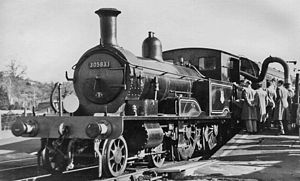LSWR 415 class

415 class Nº 30583 at Tipton St Johns in 1953, while on a railtour.
|
|||||||||||||||||||||||||||||
|
|||||||||||||||||||||||||||||
|
|||||||||||||||||||||||||||||
|
|||||||||||||||||||||||||||||
|
|||||||||||||||||||||||||||||
| Type and origin | |
|---|---|
| Power type | Steam |
| Designer | William Adams |
| Builder |
Robert Stephenson & Co. (28); Dübs & Co. (20); Neilson & Co. (11); Beyer Peacock (12) |
| Serial number | RS 2501–2518, 2601–2610 Dübs 2000–2009, 2105–2114; Neilson 3200–3210; BP 2167–2178 |
| Build date | 1882–1885 |
| Total produced | 71 |
| Specifications | |
|---|---|
| Configuration: |
|
| • Whyte | 4-4-2T |
| Gauge | 4 ft 8 1⁄2 in (1,435 mm) |
| Leading dia. | 3 ft 1 in (0.940 m) |
| Driver dia. | 5 ft 7 in (1.702 m) |
| Length | 36 ft 5 1⁄2 in (11.11 m) |
| Loco weight | 55 tons 2 cwt (124,200 lb or 56.3 t) |
| Fuel type | Coal |
| Fuel capacity | 1 long ton (1.02 t; 1.12 short tons) |
| Water cap | 1,200 imp gal (5,500 l; 1,400 US gal) |
| Boiler pressure | 160 psi (1.10 MPa) |
| Cylinders | Two, outside |
| Cylinder size | 17.5 in × 24 in (444 mm × 610 mm) |
| Performance figures | |
|---|---|
| Tractive effort | 14,919 lbf (66.36 kN) |
| Career | |
|---|---|
| Operators |
London and South Western Railway, Souther Railway, Southern Region of British Railways |
| Class | 415, later 0415 |
| Power class | LSWR / SR: K, BR: 1P |
| Nicknames | Radial Tank |
| Locale | Great Britain |
| Retired | 1916–1961 |
| Preserved | No. 488 |
| Disposition | One preserved, remainder scrapped |
The LSWR 415 class is a steam tank locomotive of 4-4-2T wheel arrangement, with the trailing wheels forming the basis of its "Radial Tank" moniker. It was designed by William Adams and introduced in 1882 for service on the London and South Western Railway (LSWR).
Originally rostered for suburban traffic, the class was soon displaced to the countryside by Dugald Drummond's M7 class. Most of the class was scrapped around the end of the First World War, and further decreases meant that all of them were due to be withdrawn by 1929. However, the class was noted for its long service on the Lyme Regis branch line, and three members of this long obsolete class were utilised on this duty until 1962, when suitable replacements became available. One has survived and can be found on the Bluebell Railway.
This locomotive, designed by William Adams, was the result of the work made to replace the stop-gap 46 Class on suburban services around London. In the event, they were also intended to supplement this class while members entered the works for rebuilding into "Radial Tank" configuration. All were built from 1882, and were also intended for medium to heavy suburban passenger traffic around the South Coast on the LSWR railway network.
William Adams' 415 (later 0415) Class was based on his earlier LSWR 46 Class, and was specifically designed with London suburban services in mind. The design was based on a 4-4-0 design with a trailing axle added to support an enlarged coal bunker, a necessity for the intensive suburban services of the LSWR network. The radial axlebox worked in a corresponding curved hornblock the centre of which was struck near the middle of the chassis. The device was originally invented in 1863 by William Bridges Adams (no relation) and could be applied to a leading or trailing axle but was generally preferred for the latter. Many other engineers used it, including Webb, R. J. Billinton, H. G. Ivatt, and D.E. Marsh. Many of the tank engines so fitted earned the soubriquet "Radial Tanks", or simply "Radials". The enlarged coal bunker was also designed to incorporate a back tank for extra water storage in addition to the capacity of the side tanks. Valve gear was of modified Stephenson type.
...
Wikipedia
